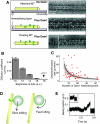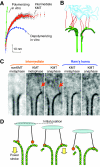Tubulin depolymerization may be an ancient biological motor
- PMID: 20930138
- PMCID: PMC2959111
- DOI: 10.1242/jcs.067611
Tubulin depolymerization may be an ancient biological motor
Abstract
The motions of mitotic chromosomes are complex and show considerable variety across species. A wealth of evidence supports the idea that microtubule-dependent motor enzymes contribute to this variation and are important both for spindle formation and for the accurate completion of chromosome segregation. Motors that walk towards the spindle pole are, however, dispensable for at least some poleward movements of chromosomes in yeasts, suggesting that depolymerizing spindle microtubules can generate mitotic forces in vivo. Tubulin protofilaments that flare outward in association with microtubule shortening may be the origin of such forces, because they can move objects that are appropriately attached to a microtubule wall. For example, some kinetochore-associated proteins can couple experimental objects, such as microspheres, to shortening microtubules in vitro, moving them over many micrometers. Here, we review recent evidence about such phenomena, highlighting the force-generation mechanisms and different coupling strategies. We also consider bending filaments of the tubulin-like protein FtsZ, which form rings girding bacteria at their sites of cytokinesis. Mechanical similarities between these force-generation systems suggest a deep phylogenetic relationship between tubulin depolymerization in eukaryotic mitosis and FtsZ-mediated ring contraction in bacteria.
Figures






Similar articles
-
Microtubule Tip Tracking by the Spindle and Kinetochore Protein Ska1 Requires Diverse Tubulin-Interacting Surfaces.Curr Biol. 2017 Dec 4;27(23):3666-3675.e6. doi: 10.1016/j.cub.2017.10.018. Epub 2017 Nov 16. Curr Biol. 2017. PMID: 29153323 Free PMC article.
-
Direct measurement of conformational strain energy in protofilaments curling outward from disassembling microtubule tips.Elife. 2017 Jun 19;6:e28433. doi: 10.7554/eLife.28433. Elife. 2017. PMID: 28628007 Free PMC article.
-
Measurement of Microtubule Half-Life and Poleward Flux in the Mitotic Spindle by Photoactivation of Fluorescent Tubulin.Methods Mol Biol. 2020;2101:235-246. doi: 10.1007/978-1-0716-0219-5_15. Methods Mol Biol. 2020. PMID: 31879908
-
[Investigation of molecular machine that integrates microtubules depolymerization and chromosomes movement in mitosis].Ross Fiziol Zh Im I M Sechenova. 2013 Feb;99(2):153-65. Ross Fiziol Zh Im I M Sechenova. 2013. PMID: 23650730 Review. Russian.
-
In vitro assays to study the tracking of shortening microtubule ends and to measure associated forces.Methods Cell Biol. 2010;95:657-76. doi: 10.1016/S0091-679X(10)95033-4. Methods Cell Biol. 2010. PMID: 20466158 Free PMC article. Review.
Cited by
-
In vitro reconstitution of lateral to end-on conversion of kinetochore-microtubule attachments.Methods Cell Biol. 2018;144:307-327. doi: 10.1016/bs.mcb.2018.03.018. Epub 2018 May 11. Methods Cell Biol. 2018. PMID: 29804674 Free PMC article.
-
Engineered, harnessed, and hijacked: synthetic uses for cytoskeletal systems.Trends Cell Biol. 2012 Dec;22(12):644-52. doi: 10.1016/j.tcb.2012.09.005. Epub 2012 Oct 8. Trends Cell Biol. 2012. PMID: 23059001 Free PMC article. Review.
-
Tubulin bond energies and microtubule biomechanics determined from nanoindentation in silico.J Am Chem Soc. 2014 Dec 10;136(49):17036-45. doi: 10.1021/ja506385p. Epub 2014 Nov 25. J Am Chem Soc. 2014. PMID: 25389565 Free PMC article.
-
Reconstituting the kinetochore–microtubule interface: what, why, and how.Chromosoma. 2012 Jun;121(3):235-50. doi: 10.1007/s00412-012-0362-0. Chromosoma. 2012. PMID: 22289864 Free PMC article. Review.
-
Chromosome biorientation produces hundreds of piconewtons at a metazoan kinetochore.Nat Commun. 2016 Oct 20;7:13221. doi: 10.1038/ncomms13221. Nat Commun. 2016. PMID: 27762268 Free PMC article.
References
-
- Brinkley B. R., Stubblefield E. (1966). The fine structure of the kinetochore of a mammalian cell in vitro. Chromosoma 19, 28-43 - PubMed
-
- Cassimeris L., Inoue S., Salmon E. D. (1988). Microtubule dynamics in the chromosomal spindle fiber: analysis by fluorescence and high-resolution polarization microscopy. Cell Motil. Cytoskeleton 10, 185-196 - PubMed
-
- Cheeseman I. M., Chappie J. S., Wilson-Kubalek E. M., Desai A. (2006). The conserved KMN network constitutes the core microtubule-binding site of the kinetochore. Cell 127, 983-997 - PubMed
Publication types
MeSH terms
Substances
Grants and funding
LinkOut - more resources
Full Text Sources
Other Literature Sources
Molecular Biology Databases

